Blog - Foot Doctor, Chambersburg and McConnellsburg, PA
Orthotics and Heel Spurs
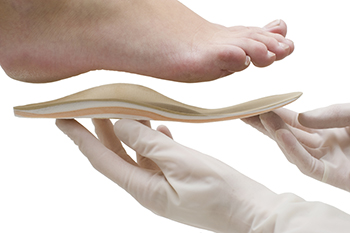
Heel spurs are pesky little bony growths that can develop on the bottom of the heel bone in the feet. Heel spurs are shaped like hooks. Since orthotics are devices that can help mitigate pain and treat foot conditions, many patients with heel spurs are curious about whether or not orthotics may be used to treat heel spurs. Interestingly, heel spur inserts can help with just that. Orthotic devices used for heel spurs typically come with significantly deep heel cups. Additionally, they will have major cushioning that is meant to increase the extent to which the device absorbs shock during weight-bearing activities. Typically, these orthotic devices can be made of a range of different materials, including foam and gel. If you are someone that struggles with heel spurs, consider contacting a podiatrist today to learn if you would benefit from the use of orthotics. Schedule an appointment today.
If you are having discomfort in your feet and would like to try orthotics, contact Dr. Steven Schwartz from Pennsylvania. Our doctor can provide the care you need to keep you pain-free and on your feet.
What Are Orthotics?
Orthotics are inserts you can place into your shoes to help with a variety of foot problems such as flat feet or foot pain. Orthotics provide relief and comfort for minor foot and heel pain but can’t correct serious biomechanical problems in your feet.
Over-the-Counter Inserts
Orthotics come in a wide variety of over-the-counter inserts that are used to treat foot pain, heel pain, and minor problems. For example, arch supports can be inserted into your shoes to help correct overarched or flat feet, while gel insoles are often used because they provide comfort and relief from foot and heel pain by alleviating pressure.
Prescription Orthotics
If over-the-counter inserts don’t work for you or if you have a more severe foot concern, it is possible to have your podiatrist prescribe custom orthotics. These high-quality inserts are designed to treat problems such as abnormal motion, plantar fasciitis, and severe forms of heel pain. They can even be used to help patients suffering from diabetes by treating foot ulcers and painful calluses and are usually molded to your feet individually, which allows them to provide full support and comfort.
If you are experiencing minor to severe foot or heel pain, it’s recommended to speak with your podiatrist about the possibilities of using orthotics. A podiatrist can determine which type of orthotic is right for you and allow you to take the first steps towards being pain-free.
If you have any questions please contact our offices located in Chambersburg, and Mcconnellsburg, PA . We offer the newest diagnostic and treatment technologies for all your foot and ankle needs.
Foot Blisters and Children

Blisters are certain areas of the skin that can be covered by a bubble-like substance, filled with some kind of bodily fluid. Blisters can often cause an individual a considerable amount of discomfort. Blisters are also generally unsightly. It is important to note that children can develop blisters on their feet for many different reasons. Notably, blisters can result from hand, foot, and mouth disease. As a result of this disease, children typically develop spots on their feet and hands. These spots can then lead to blisters. Parents should be aware of the fact that the fluid in the blisters, if spread, can also transmit the disease. Therefore, if your child has hand, foot, and mouth disease, you should be especially mindful of any blisters that may develop. Contact a podiatrist today if you have concerns about this disease.
Blisters are prone to making everyday activities extremely uncomfortable. If your feet are hurting, contact Dr. Steven Schwartz of Pennsylvania. Our doctor can provide the care you need to keep you pain-free and on your feet.
Foot Blisters
Foot blisters develop as a result of constantly wearing tight or ill-fitting footwear. This happens due to the constant rubbing from the shoe, which can often lead to pain.
What Are Foot Blisters?
A foot blister is a small fluid-filled pocket that forms on the upper-most layer of the skin. Blisters are filled with clear fluid and can lead to blood drainage or pus if the area becomes infected.
How Do Blisters Form?
Blisters on the feet are often the result of constant friction of skin and material, usually by shoe rubbing. Walking in sandals, boots, or shoes that don’t fit properly for long periods of time can result in a blister. Having consistent foot moisture and humidity can easily lead to blister formation.
Prevention & Treatment
It is important to properly care for the affected area in order to prevent infection and ease the pain. Do not lance the blister and use a Band-Aid to provide pain relief. Also, be sure to keep your feet dry and wear proper fitting shoes. If you see blood or pus in a blister, seek assistance from a podiatrist.
If you have any questions, please feel free to contact our offices located in Chambersburg, and Mcconnellsburg, PA . We offer the newest diagnostic and treatment technologies for all your foot care needs.
Treatment Methods for a Broken Toe
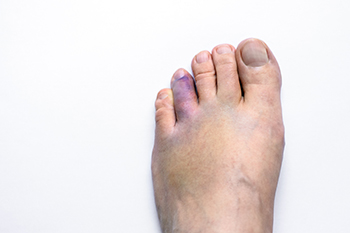
A common reason people may break their toe is from stubbing it into a wall or piece of furniture. This can cause the toe to immediately become bruised, swollen, and extremely painful. Dropping a heavy object on the toe may cause it to become fractured, and medical attention is often sought for relief. If the break is severe, a bone may protrude from the skin, often causing the toe to appear deformed. One of the first things to do if a broken toe has happened is to refrain from putting weight on it. This is done by frequently elevating the affected foot and choosing effective treatment methods. Mildly broken toes may benefit from using the buddy-taping method. This is done by taping the broken toe to the toe next to it, which is often adequate in providing the necessary support as it heals. Severely fractured toes may require a cast or a protective boot to be worn, and a podiatrist can determine which treatment method is best for you.
A broken toe can be very painful and lead to complications if not properly fixed. If you have any concerns about your feet, contact Dr. Steven Schwartz from Pennsylvania. Our doctor will treat your foot and ankle needs.
What to Know About a Broken Toe
Although most people try to avoid foot trauma such as banging, stubbing, or dropping heavy objects on their feet, the unfortunate fact is that it is a common occurrence. Given the fact that toes are positioned in front of the feet, they typically sustain the brunt of such trauma. When trauma occurs to a toe, the result can be a painful break (fracture).
Symptoms of a Broken Toe
- Throbbing pain
- Swelling
- Bruising on the skin and toenail
- The inability to move the toe
- Toe appears crooked or disfigured
- Tingling or numbness in the toe
Generally, it is best to stay off of the injured toe with the affected foot elevated.
Severe toe fractures may be treated with a splint, cast, and in some cases, minor surgery. Due to its position and the pressure it endures with daily activity, future complications can occur if the big toe is not properly treated.
If you have any questions please feel free to contact our offices located in Chambersburg, and Mcconnellsburg, PA . We offer the newest diagnostic and treatment technologies for all your foot and ankle needs.
Morton’s Neuroma and Shoes
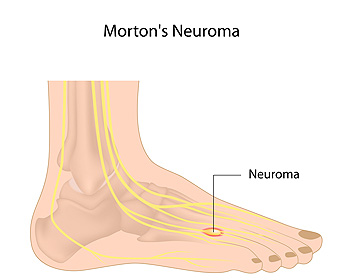
The nerves in the feet can be detrimentally impacted by several different foot conditions that can cause pain and discomfort. Morton’s neuroma is a foot condition of this kind that impacts nerves in between the toes of the feet. The tissues around the nerves in this area of the feet can become thickened. As a result of Morton’s neuroma, the ball of the foot can become inflamed and quite painful. The shoes that one wears can be a significant contributing factor to the aggravation of Morton’s neuroma. Shoes that have particularly high heels and that also have a very tight fit can be a potentially aggravating cause of Morton’s neuroma. Typically, shoes that have low heels are a better fit for individuals with Morton’s neuroma because the shape of the shoe does not put excess pressure on the ball of the foot, where the foot is most susceptible to pain. If you are struggling with Morton’s neuroma, contact a podiatrist today.
Morton’s neuroma is a very uncomfortable condition to live with. If you think you have Morton’s neuroma, contact Dr. Steven Schwartz of Pennsylvania. Our doctor will attend to all of your foot care needs and answer any of your related questions.
Morton’s Neuroma
Morton's neuroma is a painful foot condition that commonly affects the areas between the second and third or third and fourth toe, although other areas of the foot are also susceptible. Morton’s neuroma is caused by an inflamed nerve in the foot that is being squeezed and aggravated by surrounding bones.
What Increases the Chances of Having Morton’s Neuroma?
- Ill-fitting high heels or shoes that add pressure to the toe or foot
- Jogging, running or any sport that involves constant impact to the foot
- Flat feet, bunions, and any other foot deformities
Morton’s neuroma is a very treatable condition. Orthotics and shoe inserts can often be used to alleviate the pain on the forefront of the feet. In more severe cases, corticosteroids can also be prescribed. In order to figure out the best treatment for your neuroma, it’s recommended to seek the care of a podiatrist who can diagnose your condition and provide different treatment options.
If you have any questions, please feel free to contact our offices located in Chambersburg, and Mcconnellsburg, PA . We offer the newest diagnostic and treatment technologies for all your foot care needs.
A Broken Foot Is a Common Foot Injury
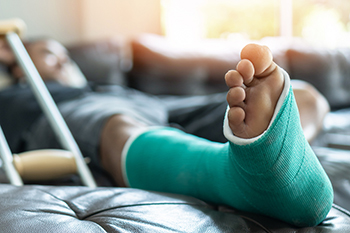
It is easy to slip, fall, and incur a broken foot. A fractured foot is a common injury that can happen suddenly or from chronic overuse. It may also occur from twisting it beyond its normal range of motion or when a heavy object drops on it. The symptoms often experienced with a broken foot include consistent pain, the inability to walk, and the foot may be bruised or swollen. In severe fractures, a bone may have become displaced, and will need to be put back into place, often through surgery. Many people who have a broken foot will have a proper diagnosis performed, which consists of having an X-ray taken. This is helpful in determining the severity of the fracture and treating it accordingly. It is common for patients who have fractured their foot to wear a protective boot or a cast, which is helpful in maintaining stability as the healing process occurs. If you have endured a broken foot, it is suggested that you contact a podiatrist sooner rather than later who can help you with the correct treatment.
A broken foot requires immediate medical attention and treatment. If you need your feet checked, contact Dr. Steven Schwartz from Pennsylvania. Our doctor can provide the care you need to keep you pain-free and on your feet.
Broken Foot Causes, Symptoms, and Treatment
A broken foot is caused by one of the bones in the foot typically breaking when bended, crushed, or stretched beyond its natural capabilities. Usually the location of the fracture indicates how the break occurred, whether it was through an object, fall, or any other type of injury.
Common Symptoms of Broken Feet:
- Bruising
- Pain
- Redness
- Swelling
- Blue in color
- Numbness
- Cold
- Misshapen
- Cuts
- Deformities
Those that suspect they have a broken foot shoot seek urgent medical attention where a medical professional could diagnose the severity.
Treatment for broken bones varies depending on the cause, severity and location. Some will require the use of splints, casts or crutches while others could even involve surgery to repair the broken bones. Personal care includes the use of ice and keeping the foot stabilized and elevated.
If you have any questions please feel free to contact our offices located in Chambersburg, and Mcconnellsburg, PA . We offer the newest diagnostic and treatment technologies for all your foot and ankle needs.
Common Symptoms of Neuropathy
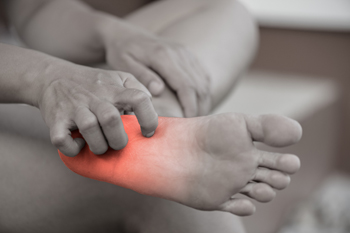
The feet are typically affected with the condition that is known as peripheral neuropathy. It causes the inability to feel sensations on the feet, and existing cuts, bruises, and scrapes may go unnoticed. There are various categories of specific types of nerves, consisting of sensory, motor, and autonomic nerves. Pain and touch are products of the sensory nerves, while the motor nerves control the muscles. Automatic functions of the body come from the autonomic nerves, and bladder function and blood pressure fall into this area. The symptoms that many people experience with neuropathy can include a loss of balance, weakness in the feet, in addition to a tingling or numbing sensation in the hands and feet. Diabetic patients may be prone to developing neuropathy, and infected cuts on the feet may go unnoticed, possibly leading to serious complications. If you have any symptoms that may indicate neuropathy, it is suggested that you consult with a podiatrist who can help you to manage this condition.
Neuropathy
Neuropathy can be a potentially serious condition, especially if it is left undiagnosed. If you have any concerns that you may be experiencing nerve loss in your feet, consult with Dr. Steven Schwartz from Pennsylvania. Our doctor will assess your condition and provide you with quality foot and ankle treatment for neuropathy.
What Is Neuropathy?
Neuropathy is a condition that leads to damage to the nerves in the body. Peripheral neuropathy, or neuropathy that affects your peripheral nervous system, usually occurs in the feet. Neuropathy can be triggered by a number of different causes. Such causes include diabetes, infections, cancers, disorders, and toxic substances.
Symptoms of Neuropathy Include:
- Numbness
- Sensation loss
- Prickling and tingling sensations
- Throbbing, freezing, burning pains
- Muscle weakness
Those with diabetes are at serious risk due to being unable to feel an ulcer on their feet. Diabetics usually also suffer from poor blood circulation. This can lead to the wound not healing, infections occurring, and the limb may have to be amputated.
Treatment
To treat neuropathy in the foot, podiatrists will first diagnose the cause of the neuropathy. Figuring out the underlying cause of the neuropathy will allow the podiatrist to prescribe the best treatment, whether it be caused by diabetes, toxic substance exposure, infection, etc. If the nerve has not died, then it’s possible that sensation may be able to return to the foot.
Pain medication may be issued for pain. Electrical nerve stimulation can be used to stimulate nerves. If the neuropathy is caused from pressure on the nerves, then surgery may be necessary.
If you have any questions, please feel free to contact our offices located in Chambersburg, and Mcconnellsburg, PA . We offer the newest diagnostic and treatment technologies for all your foot care needs.
Foot Massages and Reflexology May Yield Positive Benefits
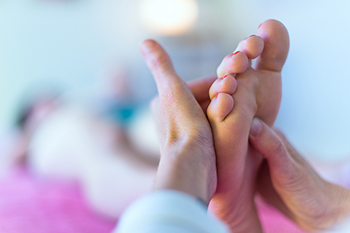
Foot massages have many benefits and may relieve existing foot pain. Reflexology and massages are performed on the feet and can positively affect the organs in the body. There are differences between the two types of foot therapy. Foot massages can be described as more of a general term for manual techniques that are applied to the feet, and this differs from reflexology in which specific practices and theories are applied. Foot reflexology uses the pressure points on the feet that correspond to various organs in the body. This can be helpful in stimulating the central nervous system which may help to promote healing. Additionally, there may be different types of foot massages, including Swedish, Shiatsu, and Thai massages. Having any type of these massages may improve circulation, reduce muscle tension, and reduce stress and pain. If you would like more information about the benefits of these types of foot therapies, please contact a podiatrist who can answer any questions you may have.
Foot therapy is often necessary for those recovering from either foot deformities or foot injuries. If you have concerns regarding therapy, consult with Dr. Steven Schwartz from Pennsylvania. Our doctor can provide the care you need to keep you pain-free and on your feet.
Most Common Injuries
People who are active or athletes are prone to a variety of injuries. Therefore, it is often important to take part in physical therapy in order to quickly get back on the right track.
What to Do When Injured
Physical Therapy – This specialized treatment will focus on the affected area, speeding up recovery and the overall healing process. It is a proven method that has helped millions of people return from any injury.
During physical therapy you will undergo regimented training to get back into full form. Training is often very difficult, especially at first when the foot feels weak. Physical therapy often involves:
Basic stretching and twisting exercises – getting the feet’s mobility and flexibility up.
Massaging – the therapist will massage the injured area in order to activate the muscles and relax them.
Strengthening Exercises – this allows the muscles in the affected area to regain their full strength, a vital step towards full recovery.
If you have any questions please feel free to contact our offices located in Chambersburg, and Mcconnellsburg, PA . We offer the newest diagnostic tools and technology to treat your foot and ankle needs.
The Strong Achilles Tendon
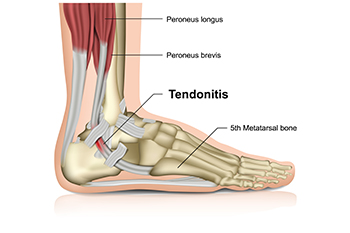
A common Achilles tendon injury is called Achilles tendinopathy. This is defined as damage that occurs in the Achilles tendon, which is located in the calf. The function of the Achilles tendon is to connect the calf muscles to the heels. It is known as the strongest and thickest tendon in the body, and is responsible for walking, running, or jumping movements. A sports mishap can result in a serious Achilles tendon injury. Achilles tendinopathy occurs when this tendon has become irritated and inflamed, and often causes severe pain and discomfort. Many people can experience this type of injury from increasing speed and mileage too quickly while running, in addition to eliminating a proper warm-up and cool-down. Wearing shoes that do not fit correctly may result in experiencing this type of injury, and this may put excess stress on the heels. The common symptoms many people have include swelling that appears at the back of the ankle, and it is difficult, if not impossible, to point and flex the foot. If you have endured this type of injury, it is strongly advised that you are under the care of a podiatrist who can help you with effective relief methods.
Achilles tendon injuries need immediate attention to avoid future complications. If you have any concerns, contact Dr. Steven Schwartz of Pennsylvania. Our doctor can provide the care you need to keep you pain-free and on your feet.
What Is the Achilles Tendon?
The Achilles tendon is a tendon that connects the lower leg muscles and calf to the heel of the foot. It is the strongest tendon in the human body and is essential for making movement possible. Because this tendon is such an integral part of the body, any injuries to it can create immense difficulties and should immediately be presented to a doctor.
What Are the Symptoms of an Achilles Tendon Injury?
There are various types of injuries that can affect the Achilles tendon. The two most common injuries are Achilles tendinitis and ruptures of the tendon.
Achilles Tendinitis Symptoms
- Inflammation
- Dull to severe pain
- Increased blood flow to the tendon
- Thickening of the tendon
Rupture Symptoms
- Extreme pain and swelling in the foot
- Total immobility
Treatment and Prevention
Achilles tendon injuries are diagnosed by a thorough physical evaluation, which can include an MRI. Treatment involves rest, physical therapy, and in some cases, surgery. However, various preventative measures can be taken to avoid these injuries, such as:
- Thorough stretching of the tendon before and after exercise
- Strengthening exercises like calf raises, squats, leg curls, leg extensions, leg raises, lunges, and leg presses
If you have any questions please feel free to contact our offices located in Chambersburg, and Mcconnellsburg, PA . We offer the newest diagnostic tools and technology to treat your foot and ankle needs.



